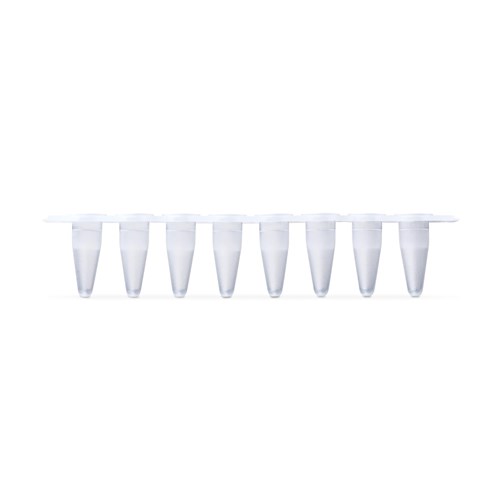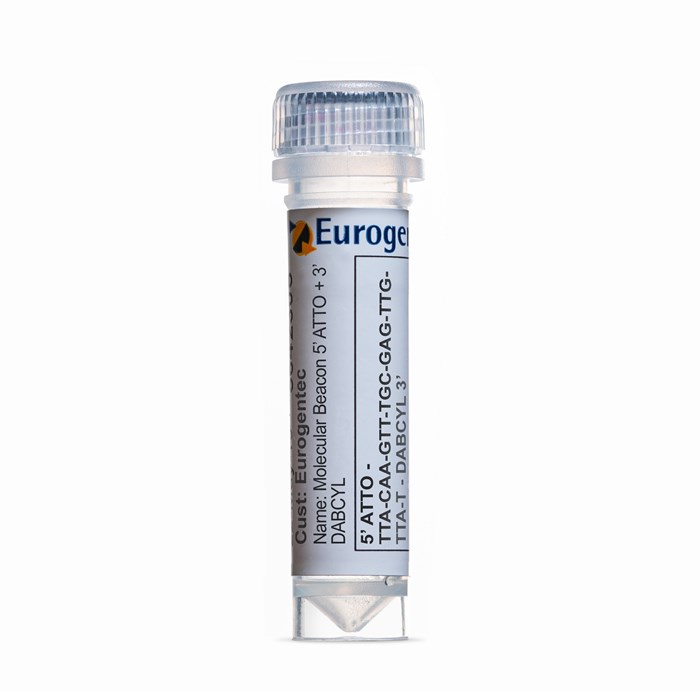M Beacon 5' ATTO 3' DABCYL - 1 probe
- Cat.Number : PB-MB290-004
- Manufacturer Ref. :
-
Availability :
In production
Molecular Beacons are probes which contain a stem-loop structure, a fluorophore and a quencher at their 5’ and 3’ ends, respectively.
Eurogentec is a historical supplier of Molecular Beacons, and offers a large number of fluorescent reporters and quenchers. All Molecular Beacons are provided double-HPLC purified and controlled by analytical HPLC and MALDI-TOF MS. The maximum length of standard Molecular Beacons is 45 bases. Molecular Beacons are provided lyophilized in individual tubes.
Eurogentec determines upon request the signal-to-noise ratio (STNR) for each Molecular Beacons by hybridizing it to its complementary sequence and comparing fluorescence to background. For FAM labelled Molecular Beacons, the STNR should be > 15. All other dyes require a signal-to-noise ratio > 10.
How do the Molecular Beacons work?
The ‘stem’ sequence keeps the fluorophore and the quencher together, but only in the absence of a sequence complementary to the ‘loop’ sequence. As long as the fluorophore and the quencher are in close vicinity, any photons emitted by the fluorophore are absorbed by the quencher. This phenomenon is called collisional (or proximal) quenching.
In the presence of a complementary sequence, the probe unfolds and hybridizes to the target, the fluorophore is displaced from the quencher, which can no longer absorb the photons emitted by the fluorophore, and the probe starts to fluoresce. The amount of signal is proportional to the amount of target sequence, and is measured in Real-Time to allow quantification of the amount of target sequence.
ATTO 390 - Absorbance = 390 nm, Emission = 479 nm
ATTO 425 - Absorbance = 436 nm, Emission = 484 nm
ATTO 465 - Absorbance = 453 nm, Emission = 508 nm
ATTO 488 - Absorbance = 501 nm, Emission = 523 nm
ATTO 495 - Absorbance = 495 nm, Emission = 527 nm
ATTO 520 - Absorbance = 516 nm, Emission = 538 nm
ATTO 532 - Absorbance = 532 nm, Emission = 553 nm
ATTO 550 - Absorbance = 554 nm, Emission = 576 nm
ATTO 565 - Absorbance = 563 nm, Emission = 592 nm
ATTO 590 - Absorbance = 594 nm, Emission = 624 nm
ATTO 594 - Absorbance = 601 nm, Emission = 627 nm
ATTO 610 - Absorbance = 615 nm, Emission = 634 nm
ATTO 620 - Absorbance = 619 nm, Emission = 643 nm
ATTO 633 - Absorbance = 629 nm, Emission = 653 nm
ATTO 637 - Absorbance = 635 nm, Emission = 659 nm
ATTO 647N - Absorbance = 644 nm, Emission = 669 nm
ATTO 655 - Absorbance = 663 nm, Emission = 684 nm
ATTO 680 - Absorbance = 680 nm, Emission = 700 nm
ATTO 700 - Absorbance = 700 nm, Emission = 719 nm
ATTO 725 - Absorbance = 729 nm, Emission = 752 nm
ATTO 740 - Absorbance = 740 nm, Emission = 764 nm
DABCYL : Quenching range [390-510]; Max 479 nm
Specifications
| Modification | |
| Post Synthesis Coupling |
|
|---|---|
| Quantity & Purity | |
| Purification Method |
|
| Storage & stability | |
| Form |
|
| Resuspension condition |
|
| Storage Conditions |
|
| Activity | |
| Usage |
|
| Codes | |
| Code Nacres |
|
You may also be interested in the following product(s)


